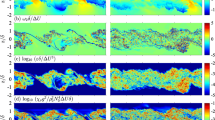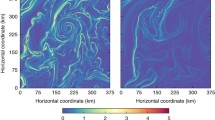Abstract
Effects of wind on quasi-steady, shallow convection in the Martian boundary layer are studied using a large-eddy simulation model. Convection in the model is generated by the radiative flux divergence and the strength of the surface heat flux, which do not vary in time. The resulting convective boundary layer exhibits transient, irregular, horizontal cellular structures, transported by wind, and a lack of well-pronounced regular horizontal rolls, observed for analogous conditions on Earth. The dimensionless statistics of turbulence are generally similar to those generated in the windless conditions, and depend on the ratio F, defined in terms of the integrated radiative and turbulent heating rates in the boundary layer. The simulations show that variations of the radiative heating influence the temperature statistics, while their effects on the wind velocity are relatively small. The horizontal velocity variances do not show a strong dependence on parameter F, in contrast with the vertical velocity variances, which are strongly dependent on F.
Similar content being viewed by others
References
French RG, Gierasch PJ, Popp BD, Yerdon RJ (1981) Global patterns in cloud forms on Mars. Icarus 45:32–43
Glendening JW (1996) Linear eddy features under strong shear conditions. J Atmos Sci 53:3430–3449
Kim S-W, Park S-U, Moeng C-H (2003) Entrainment processes in the convective boundary layer with varying wind shear. Bound Layer Meteorol 108:221–245
Michaels TI, Rafkin SCR (2004) Large-eddy simulation of atmospheric convection on Mars. Quart J Roy Meteorol Soc 130:1251–1274
Moeng CH, Sullivan PP (1994) A comparison of shear and buoyancy driven planetary boundary layer flows. J Atmos Sci 51:999–1022
Rafkin SCR, Haberle RM, Michaels TI (2001) The Mars regional atmospheric modeling system: model description and selected simulations. Icarus 151:228–256
Sorbjan Z (2005) Statistics of scalar fields in the atmospheric boundary layer based on large-eddy simulations. Part 1: free convection. Bound Layer Meteorol 116(3):467–486
Sorbjan Z (2006) Statistics of scalar fields in the atmospheric boundary layer based on large-eddy simulations. Part 2: free convection. Bound Layer Meteorol 118:1–23
Sorbjan Z (2007) Statistics of shallow convection on Mars based on large-eddy simulations. Part 1: shearless conditions. Bound Layer Meteorol (in press)
Toigo AD, Richardson MI, Ewald SP, Gierasch PJ (2003) Numerical simulation of Martian dust devils. J Geophys Res 108(6):1–14
Wang H, Ingersoll AP (2002) Martian clouds observed by Mars Global Surveyor Mars Orbiter Camera. J Geophys Res 1007:5078
Author information
Authors and Affiliations
Corresponding author
Rights and permissions
About this article
Cite this article
Sorbjan, Z. Statistics of shallow convection on Mars based on large-eddy simulations. Part 2: effects of wind shear. Boundary-Layer Meteorol 123, 143–157 (2007). https://doi.org/10.1007/s10546-006-9129-6
Received:
Accepted:
Published:
Issue Date:
DOI: https://doi.org/10.1007/s10546-006-9129-6




